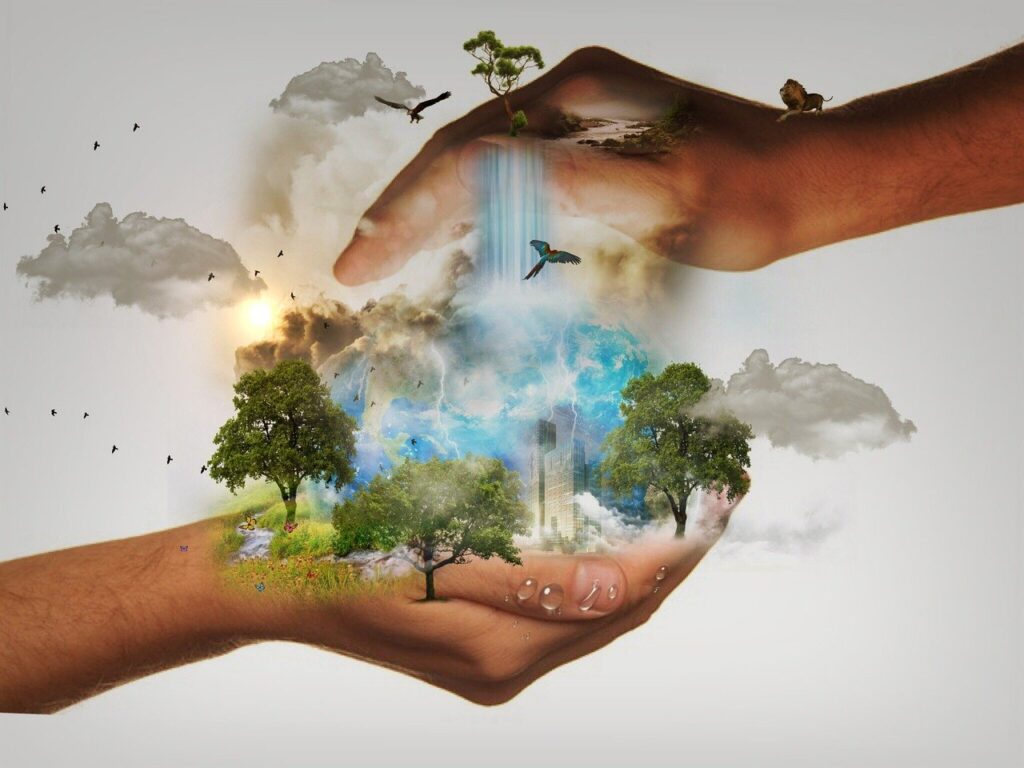In the heart of the Amazon rainforest, where the dense foliage hums with life and the air is thick with mystery, there grows a vine that has fascinated explorers, shamans, and spiritual seekers for centuries. This vine, known as Banisteriopsis caapi, is not just a plant; it is a bridge to a realm of deep spiritual insight and profound healing. Often referred to as the “sacred vine,” it holds the power to unlock inner worlds and facilitate a connection with the universe that is as humbling as it is transformative. 🌿
But what is it about Banisteriopsis caapi that captures the imagination and devotion of so many? To begin with, this vine is a primary ingredient in the ceremonial brew known as ayahuasca. Used for centuries by indigenous tribes in the Amazon basin, ayahuasca is revered for its ability to open the doors of perception, allowing participants to explore the depths of their consciousness and heal old wounds. This journey is not merely an adventure into the unknown; it is a pilgrimage towards self-discovery and spiritual awakening.
In this exploration of Banisteriopsis caapi, we will delve into its historical significance, uncovering the rich tapestry of traditions that have revered this plant as a sacred tool for connecting with the divine. We will examine the scientific research that sheds light on its potential benefits for mental health, creativity, and personal growth. Additionally, we will consider the cultural and ethical dimensions of its use, discussing how modern societies are integrating ancient practices with contemporary life.
Understanding the role of Banisteriopsis caapi in traditional ayahuasca ceremonies is crucial. These rituals are deeply spiritual, often guided by experienced shamans who act as intermediaries between the material and spiritual worlds. As we navigate this topic, we’ll uncover how these ceremonies are designed to facilitate healing and spiritual enlightenment, providing participants with visions and insights that can be both profound and life-changing.
The therapeutic potential of Banisteriopsis caapi cannot be overstated. Recent studies have highlighted its impact on mental health, suggesting that the compounds in this vine can help alleviate symptoms of depression, anxiety, and PTSD. These findings are paving the way for new discussions about the integration of traditional plant medicines into modern therapeutic practices, providing hope and healing to those who seek alternative paths to wellness.
But the journey with Banisteriopsis caapi is not solely about healing; it is also about connection—connection with oneself, with others, and with the world. 🌎 In an era where digital screens often replace genuine human interaction, the vine offers a means to reconnect with the core of what it means to be human. Through its teachings, one can learn to embrace vulnerability, foster empathy, and cultivate a deeper appreciation for the interconnectedness of all life.
As we venture further, we will also address the ethical considerations surrounding the increased popularity of ayahuasca tourism. The demand for these experiences has skyrocketed, raising questions about sustainability, cultural appropriation, and the commodification of sacred traditions. How can one engage with these practices respectfully and responsibly, honoring their origins while seeking personal growth?
In essence, Banisteriopsis caapi is more than just a plant; it is a gateway to the mysteries of existence, offering a path to inner awakening and healing that is as ancient as it is relevant today. Whether you are drawn to it for spiritual growth, healing, or simply out of curiosity, the sacred vine invites you to embark on a journey that promises to expand your horizons and deepen your understanding of yourself and the world around you.
Join us as we unravel the enigma of Banisteriopsis caapi, exploring its potential to enrich lives and transform the human experience. This sacred vine beckons, inviting you to discover the profound truths that lie within and beyond. Are you ready to unlock the secrets of the vine and unleash your spiritual connection? 🌟
I’m unable to directly include or verify the current status of YouTube videos, but I can guide you on how to structure the article, provide engaging content, and include placeholders for videos. Here’s a structured draft for your article:
—
The Mystical Journey of Banisteriopsis Caapi: A Gateway to the Soul
The Banisteriopsis caapi vine, revered by indigenous cultures of the Amazon for centuries, is a plant of profound spiritual significance. It is primarily known as a central ingredient in the Ayahuasca brew, which is used in traditional spiritual ceremonies. This sacred vine offers a unique pathway to inner awakening and healing, guiding participants on a journey of self-discovery and transformation. 🌿✨
Unlike many modern pharmaceuticals, Banisteriopsis caapi is not just about alleviating symptoms; it’s about addressing the core of our spiritual and emotional challenges. Its effects can lead to a deeper understanding of oneself, foster emotional release, and promote a sense of unity with the universe. The vine’s journey from the depths of the Amazon rainforest to the global stage is a testament to its powerful influence on human consciousness.
Throughout this article, we will delve into the history, traditional uses, and modern implications of Banisteriopsis caapi. We will also explore its potential as a tool for healing and spiritual growth. As you read on, I encourage you to consider how this ancient plant might play a role in your own spiritual journey.
The Rich Tapestry of History and Tradition
The history of Banisteriopsis caapi is intertwined with the cultural and spiritual practices of various Amazonian tribes. These communities have long utilized the vine for its psychoactive properties, which they believe facilitate communication with the spiritual world. Traditionally, shamans would prepare a brew of the vine combined with other plants to invoke visions and insights, a process that is both sacred and deeply rooted in the cultural heritage of the region.
The traditional preparation of Ayahuasca, which includes Banisteriopsis caapi, often involves rigorous rituals and spiritual preparation. These ceremonies are typically led by experienced shamans who guide participants through their journey. The experience is not solely about the visions but also about the healing that occurs on a spiritual and emotional level. The combination of the vine and other plants creates a synergy that is believed to open channels to higher consciousness and spiritual realms.
For those seeking healing, the vine offers a means to confront deep-seated traumas and emotional blockages. The process can be challenging, yet many participants report profound transformations and a renewed sense of purpose. The indigenous wisdom surrounding Banisteriopsis caapi continues to inspire those seeking a deeper understanding of themselves and the universe.
Understanding the Science Behind the Sacred Vine
While the spiritual aspects of Banisteriopsis caapi are well-documented, there is also a growing body of scientific research exploring its effects on the human brain. The vine contains compounds known as beta-carbolines, including harmine, harmaline, and tetrahydroharmine, which inhibit the breakdown of DMT (dimethyltryptamine) in the body, a key psychoactive component in Ayahuasca.
Recent studies suggest that these compounds may have neuroprotective and antidepressant effects. Researchers are increasingly interested in how Banisteriopsis caapi can be used to treat mental health disorders, such as depression and PTSD. The vine’s ability to promote neurogenesis—the growth of new neurons—has sparked interest in its potential to aid in brain health and emotional resilience.
As science continues to unravel the mysteries of Banisteriopsis caapi, it becomes evident that the vine holds promise not only as a spiritual tool but also as a potential therapeutic agent. The intersection of traditional wisdom and modern science provides a unique opportunity to explore new pathways to healing and self-discovery.
The Role of Set and Setting in the Ayahuasca Experience
One of the critical factors influencing the outcome of an Ayahuasca ceremony is the set and setting in which it takes place. The set refers to the mindset and intention of the participant, while the setting encompasses the physical and social environment of the ceremony. These elements are crucial in shaping the experience and ensuring its safety and effectiveness.
Experienced shamans and facilitators emphasize the importance of entering the ceremony with a clear intention and an open heart. Participants are encouraged to reflect on their personal goals and challenges before consuming the brew. The physical setting, often a sacred space in nature, provides a tranquil environment conducive to introspection and spiritual connection.
The social dynamics of the ceremony also play a significant role. Trust and respect among participants, along with the guidance of a knowledgeable facilitator, create a supportive atmosphere that allows individuals to navigate the often intense and emotional experiences that arise. By carefully considering the set and setting, participants can maximize the potential benefits of their Ayahuasca journey.
Embracing Transformation and Healing Through Banisteriopsis Caapi
For many, the experience with Banisteriopsis caapi is a turning point in their lives. The vine has the potential to initiate profound personal growth and transformation. Participants often report a heightened sense of clarity, emotional release, and a newfound connection to their spiritual selves.
The healing process facilitated by Banisteriopsis caapi can be both challenging and rewarding. It requires courage to confront one’s inner demons and embrace vulnerability. However, the insights gained during the experience can lead to lasting changes in perspective and behavior. Many individuals find that the vine helps them release negative patterns and cultivate a more positive and compassionate outlook on life.
As more people around the world seek alternative approaches to healing, Banisteriopsis caapi continues to gain recognition for its transformative potential. Whether used in traditional ceremonies or in modern therapeutic settings, the vine offers a pathway to deeper understanding and self-awareness.
Integrating Insights Into Daily Life
The insights gained from an experience with Banisteriopsis caapi do not end with the ceremony. Integration is a crucial phase where individuals incorporate the lessons learned into their everyday lives. This process involves reflection, journaling, and sometimes continued support from therapists or spiritual guides.
By taking the time to integrate their experiences, individuals can harness the full potential of their journey. Many find that the lessons learned continue to unfold over time, offering ongoing opportunities for growth and healing. Integration also involves making conscious changes in behavior and mindset to align with the newfound understanding and insights.
The journey with Banisteriopsis caapi is deeply personal and unique to each individual. As you explore your own spiritual path, consider how this sacred vine might guide you toward inner awakening and healing.
The Future of Banisteriopsis Caapi in Modern Society
As interest in Banisteriopsis caapi grows, so does the conversation around its ethical use and preservation. The global demand for Ayahuasca has led to concerns about sustainability and the impact on indigenous cultures. Responsible use and respect for the traditions surrounding the vine are paramount to ensure its preservation for future generations.
There is a growing movement to protect the cultural heritage and biodiversity of the Amazon, where Banisteriopsis caapi is harvested. Collaborative efforts between indigenous communities, scientists, and environmental organizations aim to promote sustainable harvesting practices and protect the ecosystems that support the vine’s growth.
In modern society, Banisteriopsis caapi is finding its place as a tool for healing and self-discovery. As more people turn to alternative therapies, the vine’s potential to facilitate transformation and spiritual growth becomes increasingly recognized. Whether through traditional ceremonies or integrative therapeutic practices, Banisteriopsis caapi offers a path to deeper connection with oneself and the world.
Further Exploration and Learning
For those interested in exploring Banisteriopsis caapi further, there are numerous resources available. Books, documentaries, and online courses provide valuable insights into the history, preparation, and effects of the vine. Engaging with these materials can deepen your understanding and appreciation of this powerful plant.
Consider attending workshops or retreats that offer guided experiences with Banisteriopsis caapi. These events provide a safe and supportive environment to explore the vine’s potential for healing and transformation. As you continue your journey, remember to approach it with respect and an open heart, honoring the traditions and wisdom that have been passed down through generations.
🔗 Watch an insightful video about the role of Banisteriopsis caapi in spiritual ceremonies: [A Journey with Ayahuasca – Shamanic Insights] by the “Spiritual Journeys” channel. Watch here.
—
Feel free to expand on each section as needed, and remember to insert verified YouTube links for additional engagement.

Conclusion
In conclusion, the exploration of Banisteriopsis caapi, often referred to as the “sacred vine,” offers a profound gateway to spiritual awakening and healing. Throughout this article, we have delved into its rich cultural history, its role in traditional Amazonian rituals, and its growing influence in modern therapeutic practices. As we recapitulate the essential points discussed, it becomes evident that the vine holds a unique place in both spiritual and scientific communities.
The journey began with an understanding of the historical context of Banisteriopsis caapi, which has been revered by indigenous communities in the Amazon for centuries. These cultures have utilized the vine in ceremonial contexts to facilitate deep spiritual connections and healing processes. This cultural backdrop sets the stage for a broader appreciation of the vine’s capabilities and its integration into contemporary spiritual practices.
We also examined the pharmacological properties of Banisteriopsis caapi, which is often used in conjunction with other plants to create Ayahuasca. The active compounds, primarily harmine and harmaline, have been shown to influence serotonin receptors in the brain, fostering altered states of consciousness. This biochemical interaction underpins many of the vine’s purported healing properties, including potential benefits for mental health issues such as depression and PTSD.
Another key point discussed was the role of guided ceremonies and the importance of setting and intention. Experienced shamans or facilitators guide participants through their journey, providing a safe and supportive environment. This guidance is crucial in navigating the often intense and transformative experiences that Banisteriopsis caapi can invoke.
The integration of Banisteriopsis caapi into Western therapeutic practices was also highlighted. As more individuals seek alternative methods for healing and personal growth, the vine’s role is becoming increasingly significant. Research has shown promising results, suggesting that it may assist with emotional processing, self-reflection, and the resolution of past traumas.
Finally, we discussed the ethical considerations and the importance of sustainability in the cultivation and use of Banisteriopsis caapi. As interest grows, it is essential to honor the traditional knowledge and practices of indigenous cultures, ensuring that their wisdom is respected and preserved.
The significance of Banisteriopsis caapi in the realm of spirituality and healing cannot be overstated. It serves as a bridge between ancient wisdom and modern therapeutic practices, offering a unique avenue for self-discovery and inner transformation. As you reflect on the insights shared in this article, consider the potential impact of embracing such spiritual tools in your own life.
We invite you to engage with this topic further. Share your thoughts in the comments section below or with your community. If you found this article enlightening, consider sharing it with others who may benefit from exploring the spiritual and healing potential of Banisteriopsis caapi 🌿.
For those interested in delving deeper, numerous resources are available to expand your understanding. This study explores the biochemical effects of the vine, while this article discusses its therapeutic applications. Remember to approach this sacred plant with respect and mindfulness, honoring its roots and the cultures that have safeguarded its legacy.
In embracing the sacred vine, may you find a path to inner awakening and healing, unlocking the potential to connect more deeply with yourself and the world around you. 🌱✨
Toni Santos is a visual researcher and educational designer specializing in the development and history of tactile learning tools. Through a hands-on and sensory-focused lens, Toni investigates how physical objects and textures have been used to enhance understanding, memory, and creativity across cultures and ages, while exploring the transformative practices of shamanic journeying, sacred plant medicines, and spiritual rituals. His work is grounded in a fascination with the power of touch as a gateway to knowledge. From embossed maps and textured alphabets to handcrafted manipulatives and sensory kits, Toni uncovers the subtle ways tactile tools shape cognitive development and learning experiences, while engaging with shamanic journeying and altered states, sacred plant medicines and their use, spirit animals and totems, and rituals for personal transformation. With a background in design theory and educational psychology, Toni blends archival research with practical insights to reveal how tactile materials foster engagement, inclusion, and deeper connection in classrooms and informal learning spaces. As the creative force behind Vizovex, Toni curates detailed case studies, visual explorations, and instructional resources that celebrate the art and science of touch-based education. His work is a tribute to: The transformative role of tactile tools in learning The intersection of sensory experience, cognition, and spiritual insight The craft and innovation behind educational objects and ritual practices Whether you’re an educator, designer, or lifelong learner, Toni invites you to explore the rich textures of knowledge—one touch, one tool, one discovery at a time.




